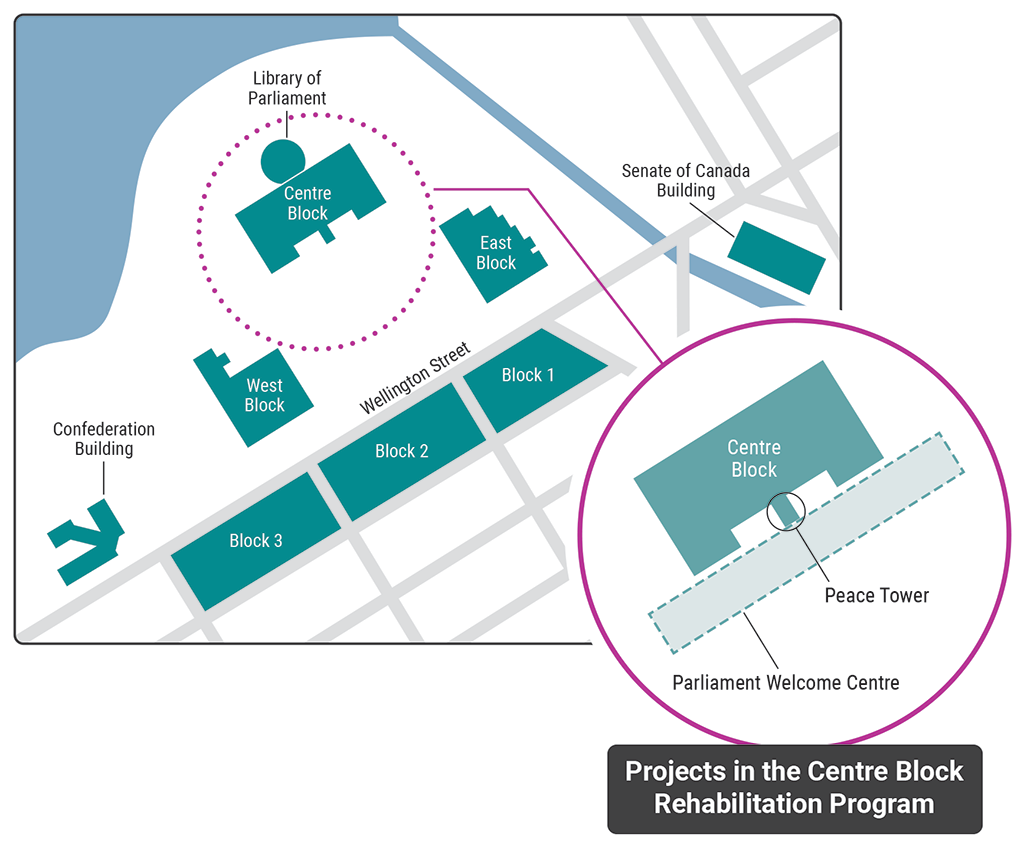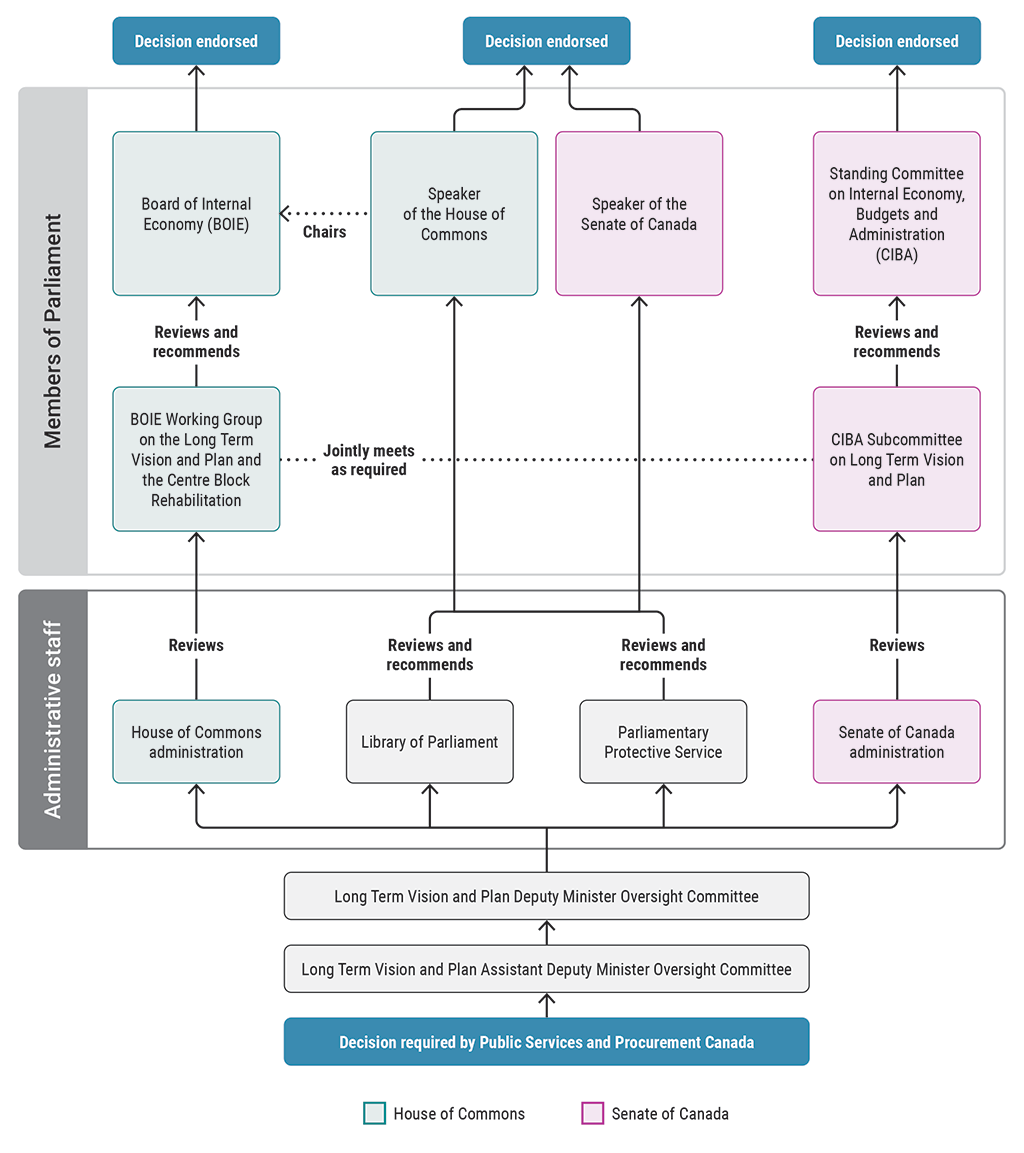2023 Reports 1 to 4 of the Auditor General of Canada to the Parliament of Canada
Report 3—Rehabilitation of Parliament’s Centre Block—Public Services and Procurement Canada
At a Glance
Overall, we found that Public Services and Procurement Canada effectively managed the early phases of the Centre Block Rehabilitation Program to rehabilitate Parliament’s Centre Block and build the new Parliament Welcome Centre, recognizing that much of the work of the planning phase, the design phase, and the initial stages of the construction phase had been done.
The rehabilitation program involves many partners, including the House of Commons, the Senate of Canada, and the Library of Parliament. Public Services and Procurement Canada consulted widely to take into account the heritage character of the Centre Block building, the needs of the public and the parliamentary partners, and environmental considerations. The department also consulted with Indigenous communities to capture the nation’s Indigenous heritage throughout the renewed Centre Block and the Parliament Welcome Centre.
During the early phases of the rehabilitation program, Public Services and Procurement Canada used a flexible approach to keep the program moving forward while waiting on the parliamentary partners to define their requirements. For example, the department moved ahead with work that needed to be done to prepare for the rehabilitation, such as demolition and excavation activities, while waiting on the decisions needed to finalize the project’s scope. As noted in our 2010 audit, the governance framework underpinning the overall rehabilitation of the Parliament buildings is fragmented, and it contributed to the delays in decision making during the planning phase.
As the program moves more into the construction phase, where making changes to elements that are built or in the process of being built becomes more difficult, the impact of delayed decisions on costs and timelines will be greater. Having timely decisions and maintaining rigorous cost management processes are important to contain costs and remain on schedule.
Why we did this audit
- The Centre Block building and the Peace Tower are iconic elements of Canadian heritage and a symbol of Canadian democracy.
- A significant amount of public funds have been allocated to the Centre Block Rehabilitation Program, and Canadians should know the progress so far and whether the program has been effectively managed.
- Having processes in place to effectively manage the cost and schedule of the Centre Block Rehabilitation Program will help achieve the best outcomes for Canadians.
Key findings
- During the planning phase, the design phase, and the initial stages of the construction phase of the Centre Block Rehabilitation Program, Public Services and Procurement Canada had so far effectively managed the scope, schedule, and costs and kept the program on schedule and within costs. One way it achieved this was by using flexible management approaches.
- The department worked with stakeholders and experts to develop the scope of the program and balance sustainability, heritage, accessibility, and inclusivity elements. It also balanced these elements with the requirements of building occupants and the need to improve and modernize the Centre Block building.
- The governance of the rehabilitation program remained fragmented, resulting in delays in obtaining key decisions on some user requirements from the parliamentary partners.
Key facts and figures
- The Centre Block was built between 1916, when fire destroyed the original building, and 1927, and it has housed the House of Commons and the Senate of Canada since 1922. It has had only minor repairs since then.
- Assessments of the Centre Block building by Public Services and Procurement Canada show many issues, such as a decaying structure, failing building systems (like mechanical and electrical), and hazardous material on site.
- The rehabilitation of the Centre Block building and the construction of the Parliament Welcome Centre started in 2016 and has a construction completion date of 2030 to 2031, with the aim of reopening 1 year later. This rehabilitation program is a large and complex project of a historic building.
- The estimated cost of construction, established in 2021, is $4.5 billion to $5 billion to rehabilitate the Centre Block and build the Parliament Welcome Centre.
Highlights of our recommendations
- Public Services and Procurement Canada should conduct a gender-based analysis plus assessment for the Centre Block Rehabilitation Program following federal government best practices in order to guide decision making, monitoring, and program review to ensure that the public spaces are inclusive and represent the diversity of all Canada’s peoples.
- To provide timely information to all Canadians, Public Services and Procurement Canada should publish its Long Term Vision and Plan annual reports within the calendar year.
Please see the full report to read our complete findings, analysis, recommendations and the audited organizations’ responses.
Exhibit highlights
The Centre Block Rehabilitation Program is part of the government’s Long Term Vision and Plan for the Parliamentary Precinct

Source: Adapted from the Public Services and Procurement Canada website
Text version
This street map shows the locations of the Parliament buildings in the Parliamentary Precinct, which includes the 3 city blocks along Wellington Street that face Parliament Hill. From west to east, the map shows the Confederation Building, the West Block building, the Centre Block building with the Library of Parliament behind it and the Peace Tower in front of it, and the East Block building. Across the Rideau Canal to the east is the Senate Building of Canada.
The map also expands the Centre Block area of the street map to highlight the projects in the Centre Block Rehabilitation Program. The projects include rehabilitating the Centre Block and adjacent Peace Tower and building the new Parliament Welcome Centre in front of the Centre Block.
Decision making remained fragmented

Text version
This flow chart shows the fragmented decision-making process involving Public Services and Procurement Canada and the parliamentary partners—that is, the House of Commons, the Senate of Canada, the Library of Parliament, and the Parliamentary Protective Service.
A decision is required by Public Services and Procurement Canada, which is supported by 2 oversight committees: the Long Term Vision and Plan Assistant Deputy Minister Oversight Committee and the Long Term Vision and Plan Deputy Minister Oversight Committee.
After the oversight committees, the department’s decision goes through 4 separate decision‑making processes that each end with an endorsement of the decision by a different party:
- The first process ends with the House of Commons Board of Internal Economy endorsing the decision. Before endorsing the decision, the board receives support from the Board of Internal Economy Working Group on the Long Term Vision and Plan and the Centre Block Rehabilitation. The working group provides support by reviewing the decision and making recommendations to the board. The working group receives support from the House of Commons administration, which also reviews the decision.
- The second process ends with the Speaker of the House of Commons endorsing the decision. Before endorsing the decision, the speaker receives support from the Library of Parliament and the Parliamentary Protective Service. The library and the service provide support by reviewing the decision and making recommendations to the speaker.
- The third process ends with the Speaker of the Senate of Canada endorsing the decision. Before endorsing the decision, the speaker receives support from the Library of Parliament and the Parliamentary Protective Service. The library and the service provide support by reviewing the decision and making recommendations to the speaker.
- The fourth process ends with the Standing Senate Committee on Internal Economy, Budgets and Administration endorsing the decision. Before endorsing the decision, the committee receives support from the Senate Internal Economy, Budgets and Administration Subcommittee on Long Tern Vision and Plan. The subcommittee provides support by reviewing the decision and making recommendations to the committee. The subcommittee receives support from the Senate of Canada administration, which also reviews the decision.
The Speaker of the House of Commons chairs the House of Commons Board of Internal Economy.
The Board of Internal Economy Working Group on the Long Term Vision and Plan and the Centre Block Rehabilitation jointly meets with the Senate Internal Economy, Budgets and Administration Subcommittee on Long Tern Vision and Plan as required.
A flexible management approach contributed to the project remaining on schedule during our audit period

Text version
This timeline shows the flexible management approach used to keep the Centre Block Rehabilitation Program on schedule.
The timeline starts at 2017, which is the start of the audit period, and ends at July 2022, which is the end of the audit period.
The schedules for the consultations with the parliamentary partners and stakeholders and for the planning, design, and construction phases overlapped:
- Consultations with the parliamentary partners and stakeholders took place during the whole audit period, from 2017 to July 2022.
- The planning phase was already in progress at the start of the audit period, in 2017, and ended in March 2021.
- The design phase started in June 2018 and was still in progress at the end of the audit period, in July 2022.
- The construction phase started in March 2020 and was still in progress at the end of the audit period, in July 2022.
In addition, excavation activities for the Parliament Welcome Centre were approved in June 2019, and the size of the Parliament Welcome Centre was decided in July 2020.
The department had spent below the approved amounts so far, and the spending will increase in the coming years
| Fiscal years | Approved funding (in millions) |
Actual spending (in millions) |
|---|---|---|
| Total | $5,121.3 | $880.7 |
|
2016–17 to 2020–21
|
$761.5 | $624.6 |
|
2021–22 to 2025–26
|
$4,359.8 | $256.1 |
Source: Public Services and Procurement Canada
Related information
Tabling date
- 27 March 2023
Related audits
- 2010 reports of the Auditor General of Canada Spring 2010 to the House of Commons
Chapter 3—Rehabilitating the Parliament Buildings
Parliamentary hearings
